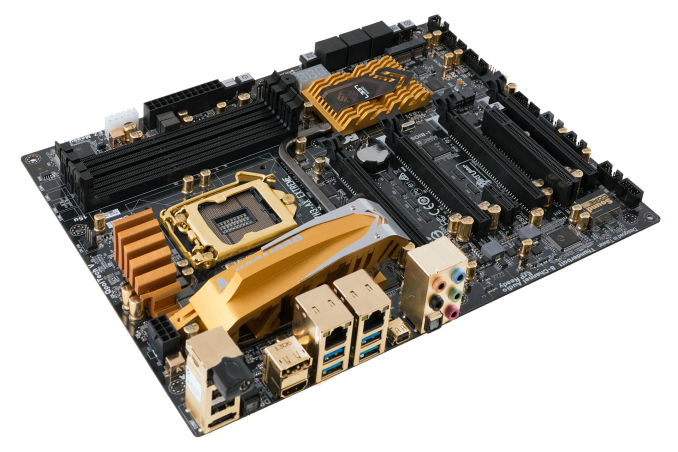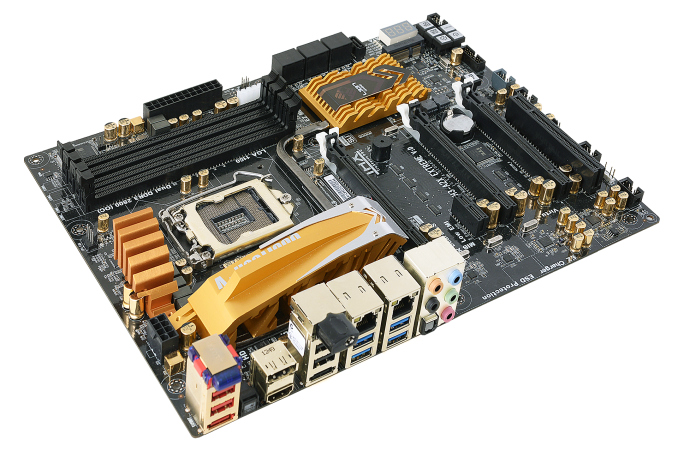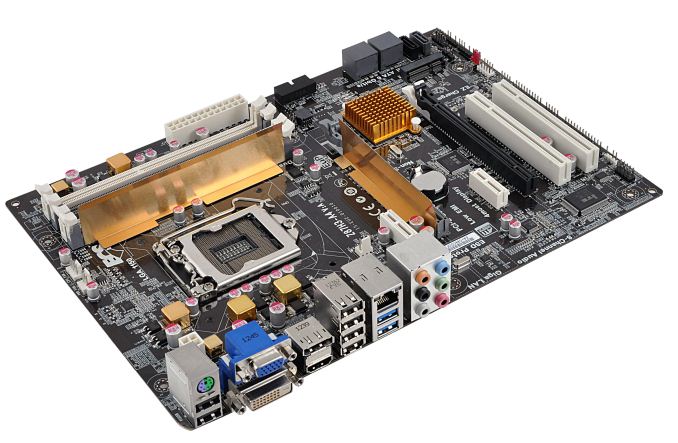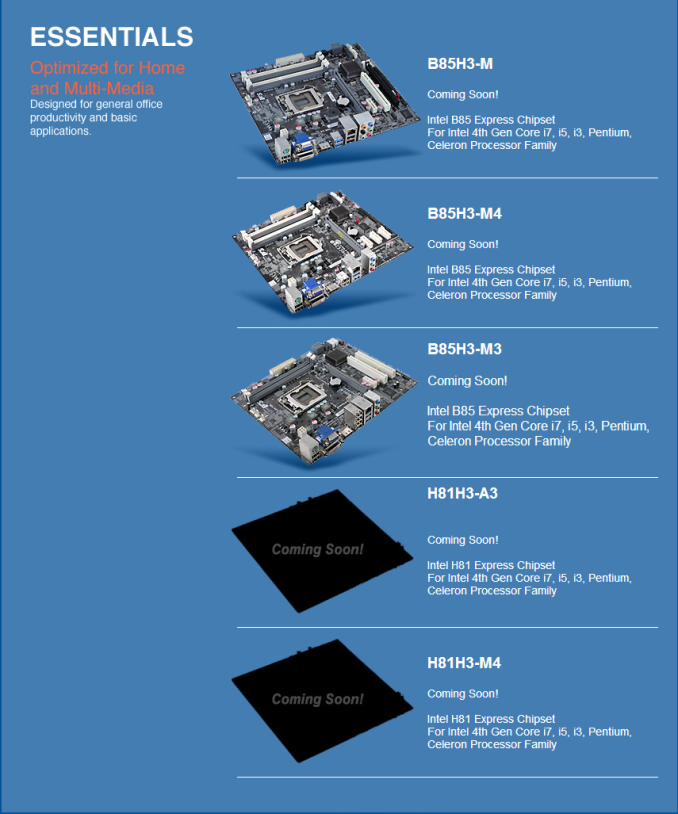Haswell Z87 Motherboard Preview: 50+ Motherboards from ASUS, Gigabyte, ASRock, MSI, ECS, Biostar and EVGA
by Ian Cutress on May 22, 2013 5:00 PM ESTECS Z87
When I started writing this preview, I had neither seen nor heard from ECS in many months. There was not an emphasis on talking to me about Haswell and pre-launch information, but between the time I started writing this preview and this sentence, ECS just so happened to launch their 8-series microsite. This microsite lists around 10 motherboard models , covering Z87 as well as B-/H-/Q- series chipsets with various tabs still with options ‘to be released’. Needless to say I got on to the email and asked my ECS contact for details. What came through was a series of high definition images and a list of most of their release SKUs:
ECS Pro Z87H3-AX Golden
ECS Pro Z87H3-A2X Golden
ECS Pro Z87H3-A2X Extreme
ECS Pro Z87H3-A2
ECS Deluxe Z87H3-A4
ECS Deluxe H87H3-M4
ECS Deluxe H87H3-M3
ECS Deluxe H87H3-M
ECS Deluxe H87H3-TI
ECS Essentials B85H3-M
ECS Essentials B85H3-M4
ECS Essentials B87H3-M3
ECS Essentials H81H3-A3
ECS Essentials H81H3-M4
ECS are splitting their range of motherboards up into the Pro, Deluxe and Essentials names. While the final SKU names might not have these in the end, it at least in part splits the model numbers up such that users can determine that the Pro boards are the high end boards. Though at first look it is possible to be confused about the Pro/Deluxe naming, given that with ASUS the Deluxe is a higher model than the Pro but with ECS it is the Pro that is the higher range.
At this point in time, we have access to the images of only several of these models. More will come in time and we will update accordingly!
ECS (Pro) Z87H3-AX Golden
Those unfamiliar with ECS’ naming scheme may be able to determine from the list above that A means ATX, the higher the Ax or Mx number the lower down the chain, and special boards get an additional moniker such as Golden or Extreme. At the top of this list is the Z87H3-AX Golden, another proponent of the Golden series. Now we took a look at the ECS FM2 Golden motherboard and it was fairly dazzling. ASUS have done something a lot more subtle, and now ECS is also scaling it down a touch:
It is worth noting that the common misconception on the ECS Golden range is that the color is actually real gold – for the most part it is not, just a golden finish. ECS have had features in the past where some of the connectors have more gold in them to help with insertion rates and resistance, but for the most part it is just a color. While we still have a large gold heatsink and IO panel, it does feel a little toned down from the past.
In terms of features on the AX, we notice a dual NIC, integrated WiFi on the IO, and four-way GPU without a PLX (thus an x8/x4/x4 + x4 scenario like the Z87X-OC and OC Formula). New to the ECS range is a series of voltage check points, but around the SATA ports we see something rather interesting. There are at least five different buttons (two of which are power/reset), and a three-digit LED debug. Now I am quite interested in seeing what they have planned for these!
ECS Z87H3-A2X Golden
Moving down the SKU stack and the A2X is reduced in part down to three-way GPU usage. We still have the golden heatsinks connecting through to the chipset, and the button options are now located in a tight corner on the bottom right of the board.
There is a Bluetooth module on the rear IO, as well as 8 SATA ports total (with one mSATA). It is worth noticing that while other manufacturers are pushing audio this generation, ECS is more focused on that array of buttons in the corner.
ECS Z87H3-A2X Extreme
For users not too keen on the golden color, it seems ECS are making a range in red as well. I can see the chipset heatsink is marked with ‘LEET Gaming’, which most likely means a tie in with a gaming clan, although there are several clans with the designation LEET Gaming.
ECS Z87H3-A4
The A4 is a more budget oriented board, more like the ECS we are used to. This is a single GPU board with an x16+x4 PCIe configuration with six SATA ports, an mSATA, two PCI slots, a single NIC, all four video outputs, and a copper shield to protect the CPU…?
ECS call this an anti-dust shield (ADS). I am not entirely sure what use, if any, the shield would be – if the board is vertical in a case then it would catch some dust perhaps. It is worth noting that we are down to a few phases on this model of board.
Other ECS Motherboards
The ECS microsite has listed several more models:
We expect to have information on these boards soon!

















70 Comments
View All Comments
Diagrafeas - Wednesday, May 22, 2013 - link
I see that the previous generation trend continues.They have 2 Physical PCI Express x16 slots and the one is electrically x4.
Why not x8?
And these boards are too few. Most have 3 PCI Express x16 physical.
Seriously how many people use three graphic cards?
meacupla - Wednesday, May 22, 2013 - link
For that matter, most people's needs can be satisfied with mATX or mITX.1x video card, if at all.
1x premium sound card, if at all.
The only reason to use ATX is if you want to give your video cards some breathing room.
Someguyperson - Wednesday, May 22, 2013 - link
I would really like to see a roundup of all the mITX boards. mITX seems to be the future and it seems like all the integration of everything in Haswell would really make a much better product than the last generation.Mr Perfect - Thursday, May 23, 2013 - link
I second that, if only because mITX is usually a second thought to ATX and mATX.silenceisgolden - Wednesday, May 22, 2013 - link
Really surprising that I don't see these specs, together on any of the boards:2 USB3 headers onboard
PS/2 omitted
2 USB2 headers
mSATA
Wi-Fi AC (also, Wi-Fi Direct anyone?)
PCIe layout of x8, x16 bypass, x8, x1, x8, x1, x8
10 6G/s SATA
I think the closest I can get is the Gigabyte z87X-OC Force, but it still seams to be missing Wi-Fi. I think there will be a decent market for USB3 Wi-Fi ac sticks during this generation.
silenceisgolden - Wednesday, May 22, 2013 - link
I also don't get why DVI and especially VGA are included on any model for this generation. Seems like a huge waste of space.JDG1980 - Thursday, May 23, 2013 - link
DVI allows the use of cheap 1440p monitors from South Korea.That said, I think enthusiast boards should break out all the video connectors on PCI brackets, so people who will be using discrete cards (probably a majority of buyers) can get a clean I/O panel.
Mr Perfect - Thursday, May 23, 2013 - link
People could use a $5 cable from Newegg to turn an HDMI output into an DVI though. They have cables that go the other way too, but then you're limited by the DVI port(no sound, etc).silenceisgolden - Thursday, May 23, 2013 - link
We're going to start seeing 4K panels hit the US soon enough though, and I'd rather a 1600p panel over those 1440p ones to be honest. And that PCIe board sounds like a brilliant idea, but Intel wants to shut out the graphics market except the very high end, not cater to gamers.Azethoth - Thursday, May 23, 2013 - link
PS/2 omitted is an ignorant request: PS/2 keyboards remain superior to USB based keyboards.You can read all about it in the various excellent high end keyboard articles. The bottom line is that PS/2 can accurately detect whatever you type in: single keys, multiple keys, chords, all the way up to a full faceroll. USB keyboards are lucky if they can manage above 6-key rollover, some high end ones trumpet their prowess at 20-key rollover. There are other issues as well.
Now my APM is too low to care so I am rocking said USB based 20-key rollover capable Corsair K-90 and every time I feel like facerolling or bashing the keyboard double handed like a monkey on meth I just refrain. However, a lot of people will not give up their superior PS/2 hardware.